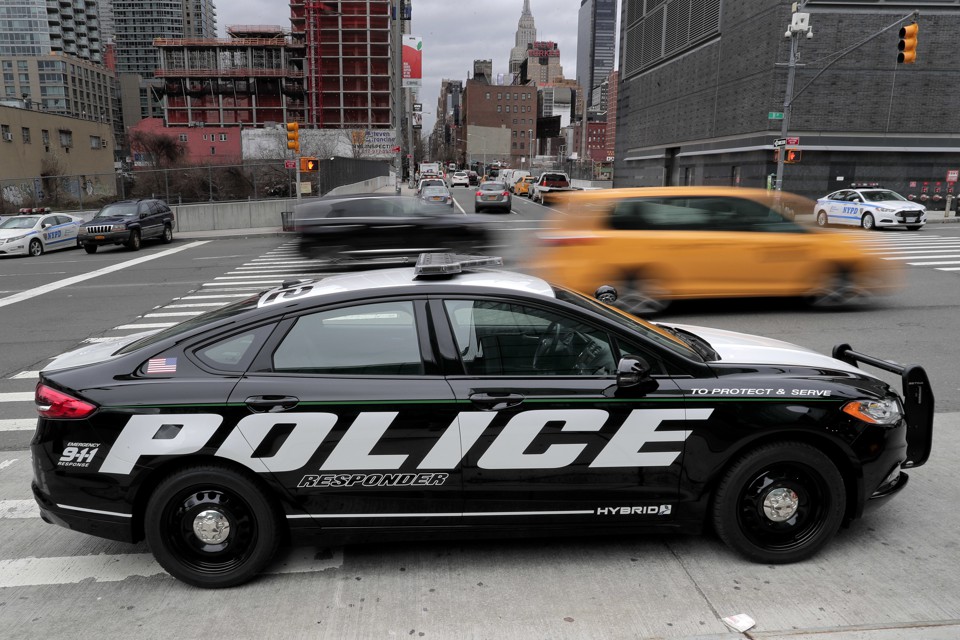
When Americans picture police cars, they usually picture Fords. The auto giant sells 63 percent of all police cars in the U.S., by its accounting. And now, the cops are getting hybrids. On Monday, Ford announced its new hybrid Police Responder, a version of its Fusion sedan made to spec for law-enforcement work.
Some of the immediate benefits of the rollout are obvious: Police departments will save an estimated $3,800 a year in fuel for each of the old V-6 cars it replaces with new Responders and their less thirsty engines. And a hybrid system’s big battery capacity will help them run the growing, power-hungry array of in-car screens, radios, sensors, and other gear police cars carry, even allowing officers to operate them with the engine off while stationary, when in the past this would require keeping the engine idling. There may even be some tactical benefits for police work: In electric mode, a hybrid Fusion is nearly silent.
“The first specially-built police vehicle was a 1920 Model T,” Joe Hinrichs, the head of Ford’s American business, told me. “And ever since then, we’ve been working with police departments across the country to meet their needs and get them what they’re looking for.” He said that every year, Ford meets with an advisory board of police officers and chiefs, to see what forces say they need. “One of the biggest asks of the last several years has been a greener pursuit-rated vehicles,” he says, referring to requests for a car that is both fuel efficient and can handle chases, clear curbs, and power through extreme weather conditions during emergencies.
It’s been a long road to hybrid cop cars. Police have traditionally driven cars that have an image opposite that of hybrids: mean-looking domestic bruisers that can fit arrestees in the back, cruise on the highway, and get up to speed quickly. Historically, police cars had to be fast. The roots of hot-rodding trace back to crime in the early decades of American motoring, when famous bank robbers such as John Dillinger escaped from heists in fast cars that the police couldn’t keep up with. NASCAR, similarly, arose from the normal-looking (hence “stock cars”) but souped-up vehicles that moonshiners used to run booze past slower cops during the Prohibition Era. This tactic became obsolete as the technology police used improved—no engine is powerful enough to outrun a radio signal—but cops cars have mostly stayed big, American-made, and powerful nonetheless. Ford’s current lineup of police cars is still called the Police Interceptor, a name that can also be found emblazoned on the 428-cubic-inch engine in the legendary GT 500 Mustangs that the car company Shelby made for Ford in the 1960s. Needless to say, they were not exactly designed for fuel efficiency.
Still, despite making good sense, the introduction of police-car hybrids is a strange and even momentous event in automotive history. In 2000, the Toyota Prius appeared in American showrooms and quickly dominated the eco-conscious sector of the car market. The first crop of hybrids that hit the American mass market consisted of gawky, Japanese-produced spectacles, and they kicked off a culture war.
At the 2003 Oscars, Hollywood eschewed the traditional parade of Rolls Royces and limos arriving on the red carpet in favor of Priuses, helpfully provided by a PR-savvy Southern California Toyota dealer. South Park ran an episode in 2006 that mocked hybrid owners for how conspicuously they showed off their moral bona fides. (The episode reaches its climax when a cloud of “smug” generated by hybrid drivers’ self-satisfaction brings some devastating environmental consequences.)
Fast forward to today, and it’s not possible to tell a Ford Fusion hybrid from its conventional internal-combustion counterpart from across the parking lot. On the fringes, a small culture war over hybrids is still being fought, as evidenced by the practice of “rolling coal,” wherein drivers of diesel trucks with vertical smokestacks record themselves flooding their engines to belch clouds of black smoke onto unsuspecting hybrids. But Ford’s new police cars show that hybrids have gone mainstream. Over time, what worked was not convincing everyone to embrace the showiness on display at the Oscars in 2003. It was allowing America to gradually come to think of hybrids simply as cars.
In car culture as in regular culture, cops have traditionally been the opposite of hippies. In the past, a hybrid police car would have been viewed like a cop in a tie-dye uniform offering to light someone’s joint. And yet today, it isn’t. It’s what institutions like the Los Angeles Police Department asked Ford to make to best serve their budgets and the day-to-day needs of their officers. The hybrid—not as a car for green-freaks or as a car to make a statement, but just as a completely regular old car—has finally arrived.
[Source:-theatlantic]